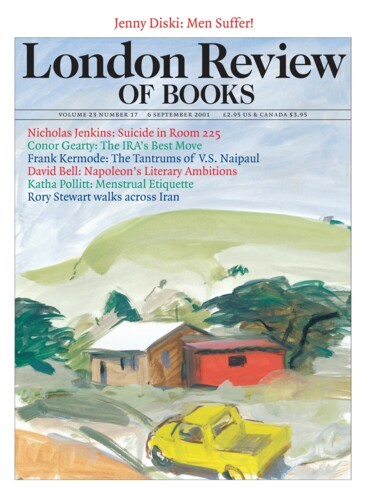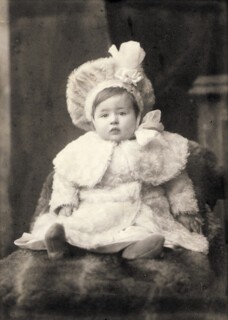As the train came into Paris the baby in the seat in front stood up and looked back over the seat. I wondered idly why one so often has a firm opinion about the gender of the very young even when clothes – in her case dungarees – tell very little. For example, my father in the picture here looks like a boy to me, despite the bows and fluff.
We stopped a day in Paris to take in an exhibition. The most touted this month is Hitchcock et l’art: coincidences fatales (works by Dalí, Magritte, Ernst and other likely suspects along with film stills, film clips and a reconstruction of the shower in the Bates Motel). But with the baby in mind we went instead to La Mode et l’enfant 1780-2000. It runs at the Musée Galliera, now the fashion museum of the City of Paris, until 18 November. Walking to the museum we passed famous fashion houses. There was a 70,463 frs tag on a coat in the window of Jacques Fath, but the exhibition turned out to be distinctly democratic. Photographs of princes and princesses in sailor suits are there but so is Gap, and – because the exhibition begins at the very start of a child’s life with the layette (the clothes for its first two years) – so are disposable nappies.
The English were early movers in the campaign to free the bound baby – John Locke spoke out against swaddling in Some Thoughts Concerning Education – but in France, despite Rousseau, it had a longer history. As babies make no comment, the relative comfort of papoose mode and free-kicking mode are hard to judge, but decisions about it are the first of many in which children have no say.
And their earliest days are inevitably undignified. Even the exhibition’s streamlined nappies, in the most technologically advanced one-way-wicking materials, always look a joke. But wearing nothing at all is hardly an option. The Western child is allowed very few years of public nakedness – even at the local paddling-pool. Indeed the baby is, in a sense, clothed before birth. In examples of pregnancy dresses one follows the transition from the concealing tent to an up-to-date pride in the achievement of pregnancy which in its most extreme manifestation (here in an illustration from a 1986 issue of Elle) exposes the swollen belly entirely. These garments say something about what adults feel when it comes to having babies, just as all adult clothes say things about the people who choose to wear them. As no baby buys for itself, and even the most determined girls will not win every fashion skirmish with their parents, young children’s clothes, even at their most informal, are like liveries or uniforms. The look is given, not chosen, and is intended, consciously or not, to say something about the wealth, taste or social position of the family.
A series of engravings from the 1770s by Moreau le Jeune shows scenes from the life of a young mother. In one the future father holds up a baby cap and smiles at the future mother: it seems that coming upon it has been his first intimation of the good news (in Charles Addams’s cartoon the father-to-be greets with similar enthusiasm the mother-to-be knitting a many-limbed garment). Among the most refined pieces of stitching shown here – thin muslin and transparent cotton with embroidery as delicate as insect wings – are examples of just such caps as the one Moreau’s father holds. Some are doubtless the work of pregnant mothers and doting grandmothers, but it is professional skill and Napoleon’s dynastic hopes which explain the hours of labour which must have gone into scattering tiny bees and flowers over the christening robe of the King of Rome in 1811. Shouldn’t the seamstresses have been doing something simpler for their own offspring? Wet nursing, which grates more strongly (and more rationally) with our idea of how mother and child should spend the early years, began as a farming-out of the babies of the rich to the cottages of the poor. As the 18th century advanced, and feelings about the family changed, the girls came to town and lived in the family (the system only finally went out of fashion after the First World War). Nurses, like other servants, were dressed by their employers but in this special case wore a head dress which incorporated whatever cap was traditional in their home region – Brittany, Gascony, Alsace and so on.
In much of the period covered by the exhibition, boys and girls wore the same clothes until they were four or five: little boys, too, wore frocks. From that point on the difference between male and female was exaggerated. Boys were often dressed as little men (or little cadets), girls as little women (but with shorter skirts). In the 20th century things went the other way. An example from 1988 shows matching but differentiated outfits in the same polka dots for boy and girl children of around 18 months – the one with legs, the other with a skirt. Eight or ten-year-old boys and girls, however, can now be seen in the same jeans and shirts.
The British contribution to French children’s clothes is neat, durable, informal and unfussy. The tailoring which had been perfected in men’s suits was adapted for boys’ and then for the coats (often velvet-collared, there are a couple here from Harrods) of the kind the Queen and her sister wore when they were little girls and the Royal Family was still respectable. Earlier there were peasant and craft borrowings – the countryman’s smock became a little girl’s dress – and cultural ones: Kate Greenaway provided potent models for moppets.
The transformation of girls’ clothes into women’s came at the very end of the 18th century, when white muslin, high-waisted shifts with short, puffed sleeves suggested a revolutionary freedom and a girlish innocence. Much later, the shift dresses with very short skirts of Yves Saint Laurent and Courrèges brought to 1960s parties styles which are remarkably close to those of 1920s nurseries.
These French clothes are not very different from those other European children wore. They fill out detail missing from the unillustrated novels, which are peopled in the reader’s mind by characters who, however specific their conversations and temperament, are usually dressed in a generic blur of old-fashioned costume in which sailor suits, chemises and dresses à l’anglaise are undifferentiated. We know (roughly) what Maisie knew, but not what Maisie wore. We know about Mrs Wix’s ‘little ugly snuff-coloured dress trimmed with satin bands in the form of scallops and glazed with antiquity’ and about some of the finery of her father’s fancy ladies; but now we also know that when Maisie saw little boys not much younger than herself they might have been in skirted sailor suits, and that her own frocks may have been like the high-waisted dresses children wear in a fashion plate from 1895.
Not that knowing how people looked doesn’t still require an act of imagination. The engravings and photographs make people stiffer than they are – at best they resemble the view people have of themselves as they arrange themselves before a mirror. Exhibitions like this are only raw material. The clothes shown are the equivalent of the animal skins and pressed plants in the cupboards of a natural history museum – and no easier to imagine in their living glory.
Send Letters To:
The Editor
London Review of Books,
28 Little Russell Street
London, WC1A 2HN
letters@lrb.co.uk
Please include name, address, and a telephone number.


